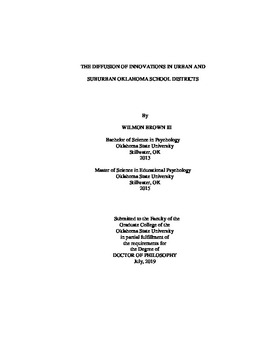| dc.contributor.advisor | Asino, Tutaleni I. | |
| dc.contributor.author | Brown, Wilmon, III | |
| dc.date.accessioned | 2020-01-30T15:03:16Z | |
| dc.date.available | 2020-01-30T15:03:16Z | |
| dc.date.issued | 2019-07 | |
| dc.identifier.uri | https://hdl.handle.net/11244/323377 | |
| dc.description.abstract | There are many disparities between urban and suburban schools, including the adoption of innovations (Huberman & Miles, 2013). This study examined the Diffusion of Innovations theory (Rogers, 2003) and its potential application to urban and suburban Oklahoma schools. The purpose of the study was to identify key elements that indicate the diffusion of innovations in urban and suburban schools. The methods of data collection for the study were survey research and document analysis. Information related to the diffusion of innovations in urban and suburban Oklahoma schools, characteristics of innovative schools and descriptions of innovative teaching practices were gathered from 145 participants who completed the survey. A Kruskal-Wallis Test was conducted to examine the differences in Profile of Instructional Technology Use in Schools scores, levels of expertise with technology, and levels of importance of methods for learning about technology according to the district type and role of each participant. Significant differences were found between urban and suburban parents, teachers and staff (χ2 = 66.81, p < .001, df = 5). The results indicated that participants who regard themselves as being members of an urban school district had significantly lower Profile of Instructional Technology Use in Schools scores than Suburban members. | |
| dc.description.abstract | The results indicated that participants who identified themselves as Suburban Teachers had significantly higher Profile of Instructional Technology Use in Schools scores than participants in other roles and district types. There was also very strong evidence (p < 0.001, adjusted using the Bonferroni correction) of a difference between groups in Profile of Instructional Technology Use in Schools scores. Urban parents, teachers, and staff are significantly different from one another, and this finding suggests that innovations are diffusing at different rates in than with suburban parents, teachers, and staff. This is significant for urban schools because it speaks to the differences in innovations being diffused. Innovations are diffusing differently throughout urban school districts, which contrasts with how innovations are being diffused in suburban school districts. Characteristics of innovative schools, definitions of innovative teaching practices, levels of expertise with educational technologies used in schools, educational budgets and perceptions of the use of educational technologies by teachers are key elements that indicate the perceptions of the diffusion of innovations in selected Oklahoma urban and suburban schools. | |
| dc.format | application/pdf | |
| dc.language | en_US | |
| dc.rights | Copyright is held by the author who has granted the Oklahoma State University Library the non-exclusive right to share this material in its institutional repository. Contact Digital Library Services at lib-dls@okstate.edu or 405-744-9161 for the permission policy on the use, reproduction or distribution of this material. | |
| dc.title | Diffusion of Innovations in Urban and Suburban Oklahoma School Districts | |
| dc.contributor.committeeMember | Davis, R. Evan | |
| dc.contributor.committeeMember | Stansberry, Susan | |
| dc.contributor.committeeMember | Thompson, Penny | |
| osu.filename | BrownIII_okstate_0664D_16341.pdf | |
| osu.accesstype | Open Access | |
| dc.type.genre | Dissertation | |
| dc.type.material | Text | |
| dc.subject.keywords | diffusion of innovations | |
| dc.subject.keywords | education | |
| dc.subject.keywords | public school | |
| dc.subject.keywords | technology | |
| thesis.degree.discipline | Education | |
| thesis.degree.grantor | Oklahoma State University | |
